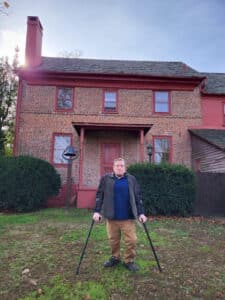Long, dangerous commutes to work are among the ways in which the American driver has “accepted mediocrity” in transportation, according to NJDOT Commissioner Jamie Fox.
Speaking in late November at a Newark Regional Business Partnership transportation symposium, Fox lamented the mediocrity, and said we can do better.
One of the “deals” we have made is the acceptance of traffic congestion as a normal part of our day. The 2013 US Census American Community Survey shows that New Jerseyans have the longest commuting times in the nation. New Jersey commutes average 30 minutes or more each way; no other state has the majority of its residents spending more time than that to get to work.
In 2011, the traffic data company INRIX reported that for every 1% reduction in vehicle miles traveled, there was as much as a 30% decrease in travel time. Active transportation (mainly bicycling and walking) are ways to reduce the number of cars on the road, with matching reductions in travel time.
The current discussion on the need to raise the state’s gas tax to generate funds for transportation infrastructure has mainly focused on the need to repair roads and bridges. The state legislators should also recognize the need for capital investment in active transportation infrastructure.
Bicycling and walking are increasingly popular — and necessary — forms of transportation, for one main reason: they are a solution to the traffic congestion that plagues our state. Offering these options would dramatically reduce the number of cars on the road in the morning and evening rush hours.
For example, residents who live within three miles of a train station or bus stop could reach them by bike or by walking, rather than sitting in automobile traffic trying to reach bus stops and already-clogged train station parking lots. Mass transit users would benefit greatly from the ability to complete the “first mile and last mile” of their commute by walking or bicycling, and thereby avoiding altogether congested roadways near transit hubs.
Active transportation improves the economies of the participating communities; provides long-term health benefits to individuals; and is environmentally friendly.
When we provide sufficient transportation infrastructure for bicycling and walking, their usage rates increase substantially enough that communities experience positive economic impacts. Communities that have made these investments benefit directly, in that bike riders and pedestrians spend more dollars per month than car drivers.
It is easier to shop when your time is not spent in search of a parking space. The nation’s first protected bike lane, installed along 9th Avenue in New York City, caused an increase of 49% in sales revenue for shops along that street, compared with just a 3% increase city-wide. Business districts across the country that have implemented bike lanes show similar gains in sales revenues, as well as decreases in commercial vacancies along the same corridors.
But we must provide walking and bicycling accommodations that are safe before there will be widespread adoption of these methods. Infrastructure amenities — such as bike lanes, crosswalks, trails, and pedestrian countdown signals — are safety and traffic-calming measures that reduce crashes between automobiles and active transportation users, thereby making the road safe for all users, and encouraging their use.
That being said, New Jersey has the nation’s second-worst bike and pedestrian deaths as percentage of all road deaths — over 30% as of 2014, based on data from National Highway Traffic Safety Administration. This statistic shows there is significant need for bike and pedestrian projects in the state, to reduce our road fatality and injury rates.
A 2013 report by the Rutgers/ Voorhees Transportation Center on the economic contribution of active transportation to the state reported:
- In 2011, active transportation infrastructure investment in the state was $63 million by governmental agencies, which:
- funded approximately 250 projects across New Jersey;
- generated $150 million in economic activity;
- created 648 jobs;
- produced $44.5 million in wages and salary;
- provided $16 million in tax revenue, and;
- contributed $75 million to the GDP in 2011.
- The combined overall economic impact of capital investments, bicycling events and activities, and the bicycling business in the state, is $497 million annually, which:
- supports 4,018 jobs;
- provides $153 million in compensation;
- adds $278 million to the state’s GDP, and;
- generates $49 million in tax revenue, accounting for almost three-fourths of the $63 million infrastructure investment.
What this tells us is there is tremendous economic potential if the state invested in active transportation infrastructure. If the economic benefit to the state is currently almost half a billion dollars per year, and the state has the nation’s second-worst percentage of road fatalities attributable to active transportation users, imagine the economic benefits when we make the roads safer. It helps very well, this amazing drug. It’s like I’m 30 years younger, really. What nobody talks about is the effect of Viagra on vision: everything becomes brighter and bluish. Call me weird but I kinda like it like that. The optimal action (50 mg) between 1 h and 2 h 30 min after taking. Also – very important! I’ve tried some pills not from https://www.asasurgery.com/viasild/ and they were dud. Take care, guys.
A study of residents of Portland, OR, one of the nation’s most bicycle-friendly states, reports that 60% of the population is “interested but concerned”; they would use active transportation to get around if the roads were made safer. Of the remaining 40%, 7% are already using active transportation, and 33% are labeled as “no way, no how.” Imagine the decrease in congestion if 60% of drivers switched to active transportation to reach transit hubs; even half that percentage would have a dramatic impact on traffic.
Active transportation infrastructure projects are labor intensive, and therefore create more jobs than highway projects. In 2010, bike and pedestrian transportation projects across the US created 11 jobs per $1 million spent, while road projects created seven jobs per $1 million spent. That represents a 57% increase in the number of jobs created for every dollar spent on transportation infrastructure. In 2012, the US spent $1.2 billion on bike and pedestrian projects; this generated 8,400 jobs nationally, according to the Federal Highway Administration.
Investments in our road infrastructure so that our roads can accommodate all users will increase safety, reduce congestion and will also translate to economic value for communities through job creation, revenue for local businesses, and tax revenues for municipalities.














































































